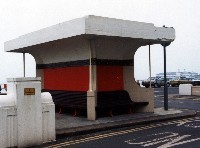Sidney Little's Hastings
Hastings and St Leonards are two seaside towns on the South Coast. They are so close together that they are often considered as one resort. In the 'thirties, Hastings and St Leonards were transformed from two slightly run-down Victorian resorts into a modern paradise of concrete and chrome. It was mainly due to one man, the Borough Engineer, Sidney Little.

Little took a walk around the town before his interview for the post. He was dismayed by what he found. Hastings and St Leonards were sleepy Victorian seaside towns that had yet to embrace the twentieth century. He told the interview panel that, if appointed, he would bring the town up-to-date. Once appointed, he set out with a resolve and determination to do just that.
Bottle Alley
In the early thirties, the Town's tramways were ripped up to make way for a completely new promenade built in reinforced concrete. The new front was a "double decker" with both upper and lower walkways. The lower walkway was built in a very functionalist style, but was relieved by decoration made from pieces of different coloured broken glass set into the concrete. The glass came from a large quantity of broken bottles that Little discovered on a rubbish tip. It is known as "Bottle Alley". The effect is striking and it looks remarkably modern given that is was built in the thirties. You could be forgiven for thinking that it was built in the 'sixties.
Underground car park

Britain's first underground car park was constructed as part of the new development. It was opened in December 1931. At the time it removed the eyesore of cars parked along the front and it is still there today, but is, of course, nowhere near adequate for its original task. There are also some rather futuristic concrete shelters dotted along the front. It was for these developments, amongst others at Hastings, that Little earned the title of "Concrete King". He was later to put his skills to use in the service of the nation when he was involved in the construction of the Mulberry floating harbour used in the D-Day landings in 1944.
Swimming pool

Sidney Little's greatest achievement was the new outdoor swimming pool or lido. As early as 1927, a campaign started in Hastings and St Leonards for a new outdoor pool, spearheaded by the Hastings' Observer. A scheme was finally approved in 1931 and Sidney Little was commissioned to do the construction. He was well versed in modern building techniques and chose to build the pool in reinforced concrete. The pool was built on a massive scale - 330 ft by 90 ft: nearly as big as Blackpool's. From the air, the design resembled a Greek or Roman amphitheatre, with curved, stepped terracing for spectators on one side and a curved deck for sunbathing on the other. Overall though, the style was functional rather than classical. There were no Doric pillars or classical references. At the centre of the pool was an impressive array of diving boards up to 10 metres high, constructed from blocks of concrete. The pool was opened to the public in June 1933.
Sadly the pool was not a great success. It was really way too large for Hastings. It only made a profit in the first year and was far too big for the town. After the War, it was bought by a holiday camp company and partially filled in. In the eighties it was demolished.
Marine Court
As well as Little's work, a new block of flats called Marine Court was built at St Leonards in 1937 replacing a terrace of Victorian houses. It was described as a liner on land. The inspiration for the design came from the Queen Mary. Immediately below Marine Court, also in 1937, a sun lounge was built on the lower deck of the promenade. The Sun Lounge could seat up to 1,000 people. At the time, it was a major social rendezvous.
Based on information in the book Sun, Sea and Sand.